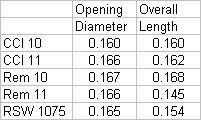I'm not sure what the the appropriate terminology is but when I say "misfires" I'm talking about the situation when the hammer falls on the percussion cap and the cap does not ignite. This thread relates to use of percussion caps in the Ruger Old Army cap-n-ball revolver.
That said I've experienced a number of "misfires" with Winchester #11 magnum percussion caps. It seems that there are times when 5 out of 6 Winchester #11 magnum percussion caps fail to ignite on first impact. If I, without modification, allow the hammer to hit the Winchester cap a second time the cap will fire. I've experimented with inserting the cap with a slight squeeze prior to insertion as well as inserting the cap as is right from the tin. In both scenarios I've experienced problems with cap ignition.
I recently bought some Remington #11 percussion caps. I haven't tried them out yet but it is obvious that the Remington caps are shorter than the Winchester magnum caps. Using digital calipers I note the Winchester magnums have a height of .162 inches on average whereas the Remington caps have a height of .146 inches. The diameter of both caps is similar.
I haven't had a chance to shoot with the Remington caps just yet. However, I'm hopeful that I'll experience fewer misfires. My current theory is that the height of the Winchester caps means that the cap does not seat as far down the nipple as it could because of the added height thus causing misfires. On the misfires the hammer must be forcing the cap on further such that the second time the hammer hits the cap it ignites.
Can anyone give their experience using #11 caps for the Ruger Old Army? I tried to find CCI caps but so far in Orlando I've only come across Winchester and Remington caps.
That said I've experienced a number of "misfires" with Winchester #11 magnum percussion caps. It seems that there are times when 5 out of 6 Winchester #11 magnum percussion caps fail to ignite on first impact. If I, without modification, allow the hammer to hit the Winchester cap a second time the cap will fire. I've experimented with inserting the cap with a slight squeeze prior to insertion as well as inserting the cap as is right from the tin. In both scenarios I've experienced problems with cap ignition.
I recently bought some Remington #11 percussion caps. I haven't tried them out yet but it is obvious that the Remington caps are shorter than the Winchester magnum caps. Using digital calipers I note the Winchester magnums have a height of .162 inches on average whereas the Remington caps have a height of .146 inches. The diameter of both caps is similar.
I haven't had a chance to shoot with the Remington caps just yet. However, I'm hopeful that I'll experience fewer misfires. My current theory is that the height of the Winchester caps means that the cap does not seat as far down the nipple as it could because of the added height thus causing misfires. On the misfires the hammer must be forcing the cap on further such that the second time the hammer hits the cap it ignites.
Can anyone give their experience using #11 caps for the Ruger Old Army? I tried to find CCI caps but so far in Orlando I've only come across Winchester and Remington caps.
Last edited:



